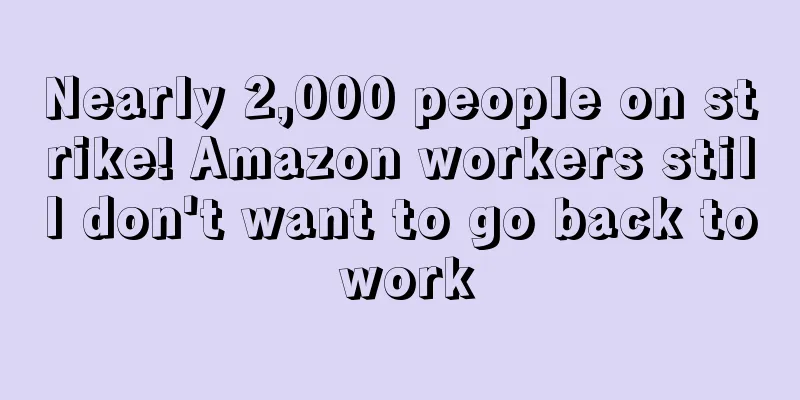Holiday orders are almost zero, and returns from Amazon surge

|
Around Halloween, sellers in the cross-border circle were wailing as a wave of order declines swept through, and at the same time, returns increased significantly after the holiday. With both orders and traffic declining, will this year's peak season be good? Amazon predicts that the company's net sales in the fourth quarter will reach 130 billion to 140 billion US dollars, and issued a "zero profit" warning.
Next, for Amazon sellers, private traffic and specialization may become the key to survival.
Almost 0! Seller: The order went to hell
During Halloween, a group of sellers were immersed in sadness. They thought that orders would steadily recover during the peak season, but in fact, they used doubts about life and it was hard to describe their current situation.
In recent days, many sellers have reported a decline in orders, with some even saying “order volume hasn’t been this bad in a long time!”
On Halloween, feedback about the decline in orders reached a peak, with many sellers lamenting: This year is a ghost story! One seller said, " Do orders also celebrate Halloween? They are all gone to hell . " Sellers who had the same experience also said that we are not surprised at all by the Halloween carnival of foreigners this year.
In terms of the specific extent of the decline in orders, some sellers have experienced a direct halving of their orders; some sellers' orders are almost zero. More feedback on recent orders is as follows:
“—Today’s order volume is outrageous; ——There are more returns than orders; ——The hair lost is more than the orders; ——This order has dropped a lot; ——Are there any orders recently? ——Foreigners have fun and excitement during Halloween, but have you ever thought about me? "
During the period of declining orders, some colleagues comforted everyone, saying that foreigners would go out to celebrate Halloween, and Amazon's sales would definitely return to pre-liberation levels overnight, and that they had successfully accumulated a lot of inventory this year. However, there were definitely many sellers who did not sell out their Halloween inventory, and some colleagues with a good mentality even came up with the "big move" of selling it next year . Do they really not care about the high storage fees during the peak season?
Sellers whose Halloween orders dropped were looking forward to the holiday being over soon so that everything could return to normal. However, after Halloween, many sellers still had no orders and ghost stories continued to unfold.
Entering November, it is the traditional fourth quarter peak season of the year. Orders and traffic will be slightly higher than before, but this good luck should not favor sellers whose orders have declined. The situation of some sellers is completely the opposite.
Some sellers said that on the first day of November, they finally felt the peak season. A small number of peers also had similar feelings, and they collectively sighed: the peak season is finally here! One seller started measuring directly, and today's orders increased by 2 times compared to yesterday .
According to senior sellers in the industry, orders and traffic have rebounded after Halloween, and the rebound is also compared with the holiday season. Consumers are now back to shopping, after all, it is already the fourth quarter. However, due to transportation issues, some sellers are facing a shortage of stock. Some sellers said that orders have been rising since the holiday, but the inventory is almost gone, and they are always on the road of shortage.
However, the most intuitive feeling of most sellers may be this: "I can clearly see that the ranking of competitors has risen, and the traffic has come, but not to me." Therefore, many sellers are still experiencing a downturn in orders after Halloween.
However, as sellers in the industry said, the sluggish orders after Halloween is not the most terrible thing. Looking at the returns and advertisements makes people feel tired.
30 returns were received early in the morning , and the return rate after the holiday was as high as 20%.
After Halloween, a wave of returns swept in. An old seller in the industry said that everyone should be prepared for the Halloween return wave, and 5%-8% is the minimum standard!
In fact, many sellers’ returns exceed this standard, and the return rate of clothing sellers is relatively high. Some sellers in this category reported that the return rate after the holiday even reached between 15% and 20%. The return rate of sellers in other categories has also exceeded 5%.
A seller who has experienced product returns said that the prediction of returns after Halloween was too accurate. This morning, he received more than 30 customer returns. All of them received the products between 10-25 and 10-30. These Americans used them for Halloween and then didn’t want them anymore.
Another seller reported his own situation, and now when he opens his mailbox, he is flooded with "refund has been initiated for order xxxxx". His peers use "three consecutive" to paralyze themselves: as long as I don't open my mailbox, there will be no returns; as long as I don't turn on my computer, I won't see returns; as long as I don't sell holiday products, there won't be too many returns.
A consumer behavior of returning a product after using it once on Halloween is interpreted by cross-border sellers as: "Customers who return the product after use are actually spending the money of customers who bought the product but did not return it."
This situation has also happened in previous years. The wave of returns after the holidays or the peak season is inevitable. At the beginning of the year, the topic of the surge in returns on the Amazon platform once became a hot search and a topic of public concern. After seeing this, many cross-border sellers exclaimed: "Faced with such a high return volume, we are the ones who silently bear it all."
Statistics show that the return rate for online shopping in the United States is as high as about 30%, which is twice that of shopping in physical stores. In 2020, American consumers returned about $428 billion worth of goods to retailers, accounting for about 10.6% of the total retail sales in the United States that year.
Amazon’s relatively relaxed refund policy has long been criticized by sellers.
Amazon 's new announcement reminds sellers that starting October 28, free returns will be provided for goods shipped by US sellers . Sellers can provide free returns for the entire selection by registering at the account level or by uploading a selected SKU list. The seller's free return badge will be displayed on the product detail page and the online return center.
However, some sellers said that the free return policy is not free, and someone has to pay for the returned goods. Since buyers do not have to pay, Amazon will not bear this cost, and these costs will eventually fall on the sellers.
As always, sellers will have to bear the cost of returns. In the process of returns, sellers' profits will be affected. In addition, this year's platform advertising costs and shipping prices have continued to rise, and price involution has intensified. Amazon sellers are making new attempts. Some are considering streamlining SKUs and moving towards specialization.
Streamlining SKUs and specialization may become the key to sellers' survival
Streamlining SKUs is a good direction for sellers. One seller introduced his plan: there are more than 400 active SKUs, and 300 will be cut after Christmas. This proportion is really high!
This seller had more SKUs last year , but has already reduced them this year, and will further reduce them after Christmas. Why reduce SKUs? For profit. Coincidentally, with Amazon's tightening policies and the sharp rise in shipping prices this year, many sellers have the same idea, and the distribution model has been abandoned by more sellers.
A seller who sells goods in bulk lamented that it is really exhausting to sell goods in bulk. After more than a year of doing it, he found that every time his account started to improve, he would face problems, such as audits and health issues. The key is that there are not many orders in the bulk model. It is not common to see hundreds of orders from a link in a short time like in the boutique model. Another seller said that the bulk model has too much inventory, and he is overwhelmed by the excessive storage fees. He cannot even clear the inventory, and there is no profit at all if he does not decisively abandon some products.
A seller in Fujian said frankly that some infringing distribution companies have almost closed down, and many bosses have lost all the money they made in the past few years. Many of them have lost all their money this year. Therefore, some new sellers who have just entered the market should not just learn how to distribute goods, but should seriously think about their business model.
The epidemic has boosted online purchasing demand, and the cross-border e-commerce industry has suddenly experienced a spurt of growth. Many new sellers rushed in without serious consideration, learning how to distribute goods and using some illegal operations, and as a result, these people became "new leeks." In May, when Amazon began a large-scale rectification, both new and old sellers were confused.
When an industry reaches its peak, it will inevitably rebound. It took only about a year from when outsiders began to pay attention to cross-border e-commerce to when the industry hit bottom. In his speech "The Power of Evolution", Liu Run mentioned that the cross-border industry soared in 2020 and hit bottom in 2021. Today, the industry has entered the "cross-border overtime" stage.
Liu Run believes that if cross-border sellers want to win this game , they must abandon the idea of relying on cleverness or even cheating , and move towards true specialization, branding, and localization. Many industry insiders have discussed this issue, and most people agree with this idea. Some people also suggested that attention should be paid to differentiation.
First of all, sellers must put specialization on the agenda, abandon the model of selling whatever sells well, doing what others do, and large-scale distribution, and return to specialization, and seriously research and develop and design products. At present, sellers are doing better and better under the guidance of specialization. In the future, if you want to grow bigger and stronger in the long run, you must build a brand and localize operations. At this stage, specialization may be the key word for the survival of small and medium-sized sellers.
The peak season is the highlight of the year-round sales. After half a year of sluggishness, sellers are betting on the peak season, hoping to turn things around. However, judging from the current forecast data and logistics and shelf conditions, this peak season has great uncertainty.
Amazon issues "zero profit" warning for the fourth quarter as epidemic dividends diminish
Last week, Amazon released its third-quarter financial report, with net sales of $110.812 billion for the quarter , up 15% year-on-year, lower than 37% in the same period last year; net profit was only $3.156 billion, down 50% year-on-year, and performance fell short of expectations. Among them, revenue from e-commerce platforms was $49.9 billion, up 3% year-on-year; revenue from physical stores was $4.27 billion, up 13% year-on-year. Revenue from services (commissions, logistics costs, etc.) from third-party sellers was $24.25 billion, up 19% year-on-year.
Amazon expects that the sharp decline in profits will continue until the end of the holiday season, and the company's net sales in the fourth quarter will reach US$130 billion to US$140 billion, a year-on-year increase of 4% to 12%. Amazon also issued a "zero profit" warning, saying that the fourth quarter profit will be between US$0 and US$3 billion, far lower than the US$6.9 billion in the same period last year and the market expectation of US$7.5 billion.
The reason is that its retail business faces challenges such as labor shortages, increased labor costs, tight global supply chains, and rising logistics costs. Amazon Chief Financial Officer Brian Olsavsky said the company expects to incur $4 billion in additional costs related to labor and inflation, as well as unfavorable factors in warehouse turnover.
Logistics has become a time bomb during the peak season.
Recently, there has been an increase in feedback from sellers about the slow listing of goods. Many sellers are looking forward to receiving "delivery notifications" from Amazon . If the goods do not arrive in time, the risk of sellers running out of stock will be greatly increased. If holiday products such as Christmas cannot be delivered and listed in time, they will undoubtedly miss this peak season.
Under the current storage capacity constraints, some sellers use air transport to quickly replenish stocks. Recently, a seller using Amazon Global Logistics received a notification, "Due to mechanical failure, your air shipment originally scheduled to arrive at Los Angeles International Airport on October 23 will be delayed. As a result, the latest estimated arrival time will be changed to November 4. After the goods arrive, we will send your goods to the operation center as soon as possible. You do not need to take any action at this stage..."
Another seller said: "I checked whether the goods arrived at the port on time and found that three shipments were delayed due to overtime. I was very anxious. In the next two days, I just hope that the products can be put on the shelves as soon as possible. I hope that most of the goods can be put on the shelves before the 10th. If not, I can only cry."
In order to improve logistics problems, Amazon announced in September that it plans to recruit 40,000 corporate employees and 125,000 fulfillment and transportation employees; in October, Amazon said it would hire 275,000 permanent and seasonal employees across the United States to alleviate the pressure brought by the holiday shopping boom.
In the fourth quarter when goods are in high demand, smooth and efficient logistics will help the peak season. However, if the seller's goods cannot be successfully put on the shelves before the sales season arrives, or buyers can only receive the purchased gifts after Christmas, then the performance of this peak season will be greatly reduced.
Compared to the giant Amazon, Shopify seems to have an easier time achieving growth.
In the past two years, the independent station track has remained hot, and many cross-border e-commerce companies have begun to deploy independent stations to increase sales channels, retain users, and thus avoid the risk of over-reliance on third-party platforms.
One noteworthy data is that from April to June this year , the average number of unique visitors per month to independent websites established by Shopify reached 1.16 billion, while Amazon's average monthly unique visitors reached 1.1 billion during the same period. This data will continue to expand this quarter, with Shopify's website expected to attract approximately 1.22 billion monthly unique visitors, while Amazon's unique visitors will be 1.13 billion.
Also last week, Shopify announced its third-quarter results ending September 30, 2021. The financial report showed that the company's third-quarter revenue was US$1.124 billion, compared with US$767 million in the same period last year, a year-on-year increase of 46.5%; net profit was US$1.148 billion, compared with US$191 million in the same period last year, a year-on-year increase of 501%.
Among them, subscription solution revenue was US$336 million, compared with US$245 million in the same period last year, a year-on-year increase of 37.1%; business solution revenue was US$788 million, compared with US$522 million in the same period last year, a year-on-year increase of 51%.
Shopify's net profit soared fivefold compared to the same period last year , but its revenue in the third quarter has slowed compared to the second quarter. The company has also said that it expects revenue to grow rapidly in 2021, but the growth rate will be lower than in 2020.
Various data show that whether it is third-party platforms represented by Amazon or independent station channels owned by Shopify, the dividends brought by the epidemic to online sales are receding, and some consumers have returned to offline stores. However, affected by factors such as the "epidemic overtime", even if the growth slows down, sales in this peak season will not be too bad.
Early shopping becomes a trend during peak season, and toys and other products will be hot sellers
According to Adobe Analytics, this year's Christmas season, US e-commerce growth may be the lowest since 2015. Online retail sales in November and December may increase by 10% to $207 billion.
According to eMarketer's forecast, during this year's Christmas season, retail sales in the United States will increase by 9% to $1.147 trillion, of which physical store sales will increase by 7.9% to $935.8 billion, and online retail sales will increase by 14.4% to $211.6 billion, accounting for 18.4% of total retail sales.
eMarketer said that although the impact of the new coronavirus epidemic still exists, "Cyber Monday" will still be the largest online retail day in the United States, with sales expected to increase by 12.4% year-on-year to US$12.1 billion; "Black Friday" will become the second largest retail day during the shopping season, with sales increasing by 15.8% to US$10.4 billion; "Thanksgiving" sales will rank third, with an expected increase of 20.7% to US$6.1 billion.
A feature of this year's peak season is that there has been an increase in consumers shopping in advance.
According to the latest foreign survey, 51% of American consumers plan to start their 2021 holiday shopping before Thanksgiving, compared with 49% last year; in addition, 29% of American consumers plan to increase their spending on holiday shopping, both of which have increased compared with last year. Among these consumers who start shopping in advance, more than two-thirds plan to start checking their gift lists in October.
NPD's chief consultant for the retail industry said that early holiday shopping has become a trend since stores opened on Thanksgiving in 2014. Last year, Amazon moved Prime Day to October due to the pandemic, and consumers were worried about delivery delays. This series of factors further promoted early shopping. The 2021 holiday season will continue previous shopping trends, and this year's shortage of goods has made consumers more aware of the need to shop in advance.
Not only in the United States, the number of people shopping in advance is also increasing in the UK.
According to a survey report by eBay, British consumers are optimistic about Christmas this year. Most people said they will shop early this Christmas, with 41% saying they will complete their Christmas shopping before December and may spend more during the holiday season. 30% of consumers said they will increase their spending this Christmas, compared to only 13% last year.
Common supply chain and transportation issues are prompting global consumers to do holiday shopping early. According to a survey by Shopkick, 22% of consumers will shop early this year, 25% expect to complete most of their shopping before Thanksgiving, and 10% expect to complete their shopping before Halloween.
It is understood that the search volume of Christmas-related keywords on eBay has been increasing since August, among which second-hand toys, sporting goods, clothing, shoes, accessories, home furnishings and gifts have become popular search terms. Compared with July, the Christmas search volume of clothing, shoes and accessories, home furnishings and DIY categories in August increased by 83% and 85% respectively.
Sales of Christmas products are starting to rise. On Amazon US, search terms such as Christmas decorations, Christmas trees, Christmas pajamas for family members, and Christmas gifts are rising in ranking. As the second stop of the peak season, a large number of products will usher in a sales peak. Can sellers increase sales and recover during the peak season? We will wait and see. Amazon Halloween orders |
>>: Lazada and Grab partner to launch same-day delivery service
Recommend
What is ChargebeeTechnologies ? ChargebeeTechnologies Review, Features
Chargebee Technologies is a PCI Level 1 certified...
What is HomeShop18? HomeShop18 Review, Features
HomeShop18 is an Indian online retailer. The compa...
What is Everyday Rewards? Everyday Rewards Review, Features
Everyday Rewards is Woolworths' loyalty progra...
French e-commerce sales exceed 129 billion euros in 2021
Recently, the French National Association of Euro...
Amazon launches new marketing features to help sellers prepare for peak season
Yesterday, Amazon UK released a new announcement ...
Zalando added nearly 8 million new users in 2020 and placed 186 million orders
The epidemic in 2020 caused the closure of a larg...
Brand rights protection broke out again, 1,082 stores were sued and frozen!
Recently, a large number of sellers have faced pr...
What is Acne Studios? Acne Studios Review, Features
Acne Studios is a fashion house based in Stockhol...
Third-party regulatory agencies in various countries are increasingly strengthening their supervision of Amazon sellers
Since the beginning of this year, sellers selling...
The seller worked hard for more than a year, lost nearly 3 million yuan, and had to pay more than 20 million yuan...
Recently, the editor saw an interesting statement...
A must-read for cross-border merchants! Tmall Global’s deposit is “unsealed” for the first time
On July 29, Tmall Global released three new merch...
The market size is as high as 8 trillion! Live shopping in South Korea is entering a rising era!
Among the non- face-to-face consumption cultures ...
What is Stamps.com? Stamps.com Review, Features
<span data-docs-delta="[[20,{"gallery"...
AliExpress logistics supply chain upgrade: improve goods efficiency and make business operations easier
On September 10, at the 2024 Cainiao Global Smart...
With 13.58 million monthly visits and 4 million new sellers, Bukalapak platform has become a dark horse!
The popular e-commerce platforms in Southeast Asi...









